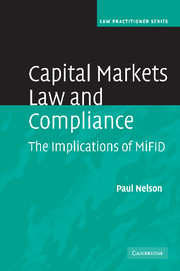Book contents
- Frontmatter
- Contents
- Preface
- List of acronyms
- Part I Evolution of capital markets regulation, FSA and the European single market
- Part II Licensing and rule application
- Part III The firm's infrastructure
- Part IV Conduct of business
- 8 Client classification and client documentation
- 9 Principles of conduct
- 10 Marketing investments
- 11 Advising clients
- 12 Improper behaviour in dealing and executing orders
- 13 Dealing and executing orders
- 14 Exchanges and MTFs
- Part V Application of rules to particular businesses
- Bibliography
- Index
10 - Marketing investments
Published online by Cambridge University Press: 03 December 2009
- Frontmatter
- Contents
- Preface
- List of acronyms
- Part I Evolution of capital markets regulation, FSA and the European single market
- Part II Licensing and rule application
- Part III The firm's infrastructure
- Part IV Conduct of business
- 8 Client classification and client documentation
- 9 Principles of conduct
- 10 Marketing investments
- 11 Advising clients
- 12 Improper behaviour in dealing and executing orders
- 13 Dealing and executing orders
- 14 Exchanges and MTFs
- Part V Application of rules to particular businesses
- Bibliography
- Index
Summary
The different regulatory regimes
Although now all of the rules on the marketing of investments are contained in, or derived from, FSMA, they differ as a result of the historical development and inter-action of different regulatory regimes for securities, collective investment schemes, bank deposits and investments generally. Figure 8 is a route map to the application of the current rules and cross-refers to the explanations in the following sections of this Chapter.
Securities
Ever since the beginning of the 20th century it was acknowledged that, notwithstanding ‘that legislation cannot protect people from the consequences of their own imprudence, recklessness or want of experience’, since subscribers cannot themselves enquire into the company's affairs, the principle of caveat emptor has a limited application and ‘therefore the prospectus on which the public are invited to subscribe [should] not only not contain any misrepresentation but … satisfy a high standard of good faith … [and] disclose everything which could reasonably influence the mind of an investor of average prudence’. The question has always been: What types of offer should trigger the mandatory prospectus contents rules? For almost 100 years the answer was: ‘any prospectus, circular, notice, advertisement or other invitation, offering to the public for subscription or purchase any shares or debentures of a company’ (1900 CA 30; substantially re-enacted in 1908 CA 285, 1929 CA 380(1), 1948 CA 455(1), 1985 CA 741), which included both an offer and an invitation to treat, as long as it was an offer to the public, not a private placement:
‘The public’ … is … a general word. No particular numbers are prescribed.[…]
- Type
- Chapter
- Information
- Capital Markets Law and ComplianceThe Implications of MiFID, pp. 265 - 305Publisher: Cambridge University PressPrint publication year: 2008

